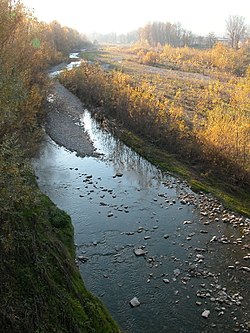| Tidone | |
|---|---|
 | |
 | |
| Location | |
| Country | Italy |
| Physical characteristics | |
| Source | |
| • location | near Monte Penice, Ligurian Apennines |
| • coordinates | 44°48′18″N9°19′16″E / 44.805°N 9.321°E |
| • elevation | 1,000 m (3,300 ft) |
| Mouth | |
• location | Po River near Sarmato and Rottofreno |
• coordinates | 45°04′44″N9°31′52″E / 45.0789°N 9.5312°E |
| Length | 47 km (29 mi) [1] |
| Discharge | |
| • average | 8 m3/s (280 cu ft/s) [2] |
| Basin features | |
| Progression | Po→ Adriatic Sea |
The Tidone is a river in the Region of Emilia Romagna in northern Italy. It is a right-bank tributary of the Po River. The stream rises in the Apennine Mountains near Monte Penice and flows in a northerly direction into the Po.
